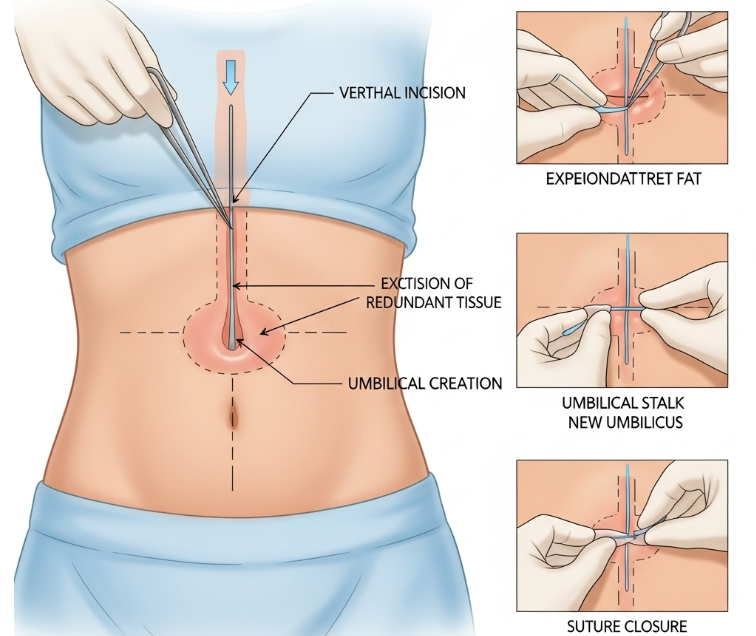Treatment Overview
Reconstruction Umbilicoplasty is a specialized cosmetic and reconstructive procedure designed to repair, restore, or recreate the belly button (navel) for patients who have lost it or experienced distortion due to surgery, trauma, scarring, or congenital conditions. Unlike simple reshaping procedures, reconstructive umbilicoplasty focuses on rebuilding a natural-looking navel with balanced proportions and minimal scarring.
In Korea, surgeons are highly skilled in advanced plastic and reconstructive techniques, using precise tissue rearrangement, cartilage or fat grafting (if needed), and hidden sutures. The goal is to provide a realistic, aesthetically pleasing belly button that blends naturally with the abdominal contour. Many Korean clinics combine reconstruction umbilicoplasty with scar revision, abdominoplasty, or liposuction for comprehensive abdominal enhancement.
Purpose & Benefits
- Recreates Natural Navel: Restores or rebuilds belly button shape after loss or distortion.
- Scar Revision: Improves belly button appearance affected by surgical or traumatic scars.
- Congenital Correction: Corrects absent or abnormal navels from birth.
- Improved Proportion: Designs a belly button that matches the patient’s abdominal contour.
- Confidence Boost: Restores self-image and comfort in swimwear and fitted clothing.
Ideal Candidates
- Patients who lost their belly button due to surgery (hernia repair, C-section, tummy tuck).
- Individuals with scarred, distorted, or absent navels.
- Men and women seeking correction for congenital belly button abnormalities.
- Adults in good health with realistic expectations.
- Patients desiring natural, scar-hidden reconstruction.
Possible Risks & Complications
- Temporary swelling, bruising, or soreness.
- Mild risk of asymmetry or irregular contour.
- Possible scar visibility (usually well-hidden inside the navel).
- Rare risks: infection, delayed wound healing, or tissue loss.
Techniques Used
- Hidden Incisions: Made inside or around the navel for discretion.
- Tissue Rearrangement: Uses existing abdominal skin to form a natural depression.
- Scar Revision: Removes or improves old scars around the navel.
- Cartilage/Fat Grafting (Optional): Used if structural support is needed.
- Fine Suturing: Ensures natural inward appearance and minimal scarring.
- Combination Surgery: May be performed with abdominoplasty or liposuction for optimal results.
Recovery & Aftercare
- 1–3 days: Mild swelling, redness, or tenderness.
- 3–5 days: Return to light activities and work.
- 1–2 weeks: Stitches (if non-dissolvable) may be removed.
- 2–4 weeks: Resume light exercise; avoid abdominal strain.
Aftercare Guidelines:
- Keep the belly button area clean and dry.
- Avoid direct trauma or strain on the abdomen during recovery.
- Follow scar-care regimen (silicone sheets, ointments, or laser if needed).
- Protect the area from sun exposure to prevent scar pigmentation.
- Attend follow-up appointments for symmetry and healing checks.
Results & Longevity
- Restored natural-looking belly button with balanced proportions.
- Minimal visible scarring thanks to hidden incisions.
- Long-lasting results when combined with proper scar management.
- Restored self-confidence, especially in swimwear and midriff-baring clothing.
Treatment Process in Korea
1. Consultation & Planning
- Surgeon evaluates belly button condition, scar tissue, and patient’s goals.
- Customized reconstruction plan created (standalone or combined with other abdominal procedures).
2. Surgery Day
- Usually performed under local anesthesia with sedation (general if combined with abdominoplasty).
- Small incisions placed discreetly around/inside navel.
- Tissues rearranged or grafted to create a natural-looking depression.
- Sutures placed for symmetry and scar minimization.
3. Post-Operative Monitoring
- Patients usually discharged the same day.
- Dressing applied to protect the reconstructed navel.
4. Follow-Up & Refinement
- Follow-ups at 1 week, 1 month, and 3–6 months.
- Optional scar-care or touch-up refinements offered if needed.
Why Korea is a Top Destination
- Surgeons experienced in cosmetic and reconstructive belly button surgery.
- Use of scar-minimizing closure techniques and advanced aftercare.
- Clinics offer combination packages (umbilicoplasty + tummy tuck + scar revision).
- Pricing is more affordable than Western countries while maintaining world-class results.
- International-friendly clinics with multilingual staff and discreet services.
Cost Range
The cost of Reconstruction Umbilicoplasty in Korea depends on the complexity, scar revision needs, and clinic reputation.
Estimated Pricing:
- Standard Reconstruction Umbilicoplasty: USD $2,000 – $4,000
- With Scar Revision or Hernia Repair: USD $3,000 – $5,500
- Combined with Mini Tummy Tuck or Liposuction: USD $4,500 – $7,500
- Premium Clinics (3D imaging + scar-care + VIP aftercare): USD $5,500 – $8,000
Additional Costs:
- Consultation & imaging: USD $50 – $200
- Medications & aftercare: USD $100 – $200
- Scar-care treatments (laser, RF, silicone patches): USD $200 – $600
Popular Clinics
- Banobagi Plastic Surgery (Seoul): Experts in reconstructive and cosmetic umbilicoplasty.
- ID Hospital (Seoul): Known for combining belly button reconstruction with tummy tuck.
- JK Plastic Surgery Center (Seoul): JCI-accredited, offering advanced scar management.
- View Plastic Surgery Clinic (Seoul): Specialists in navel reconstruction with natural results.
- JW Plastic Surgery (Seoul): Leaders in reconstructive abdominal aesthetics with hidden-scar techniques.




